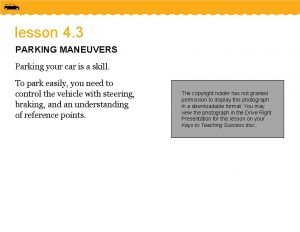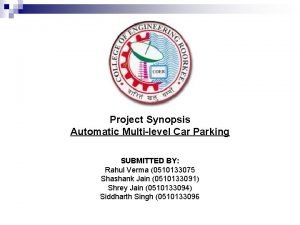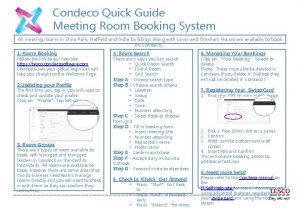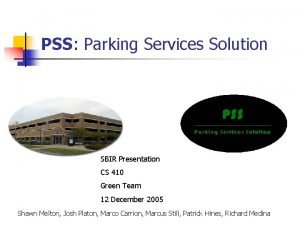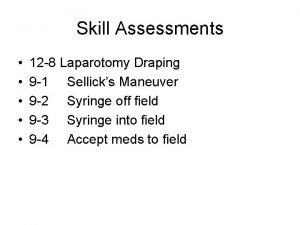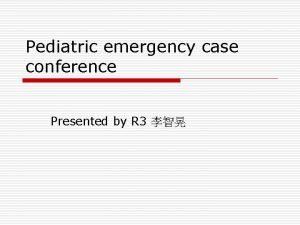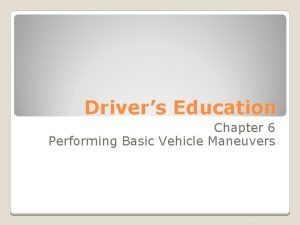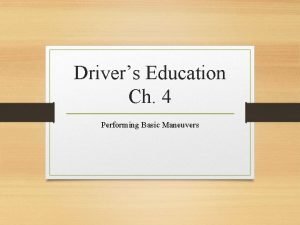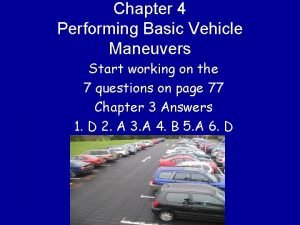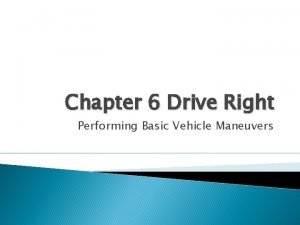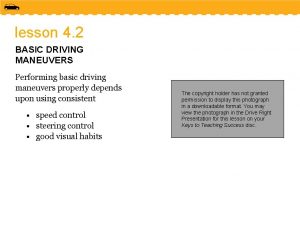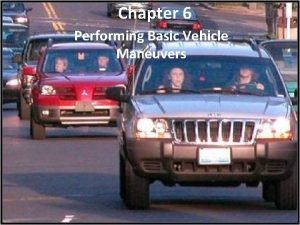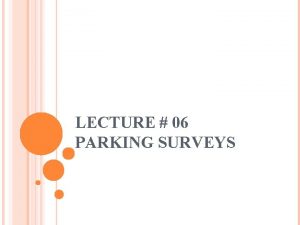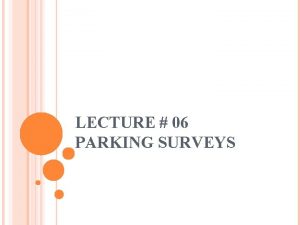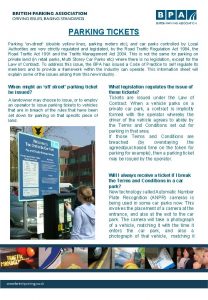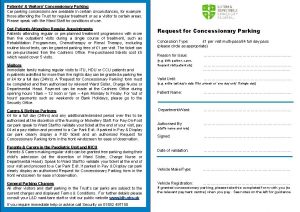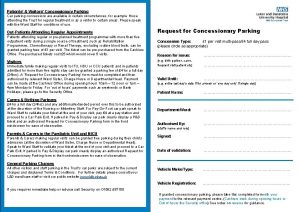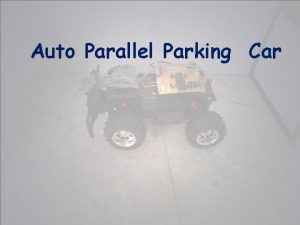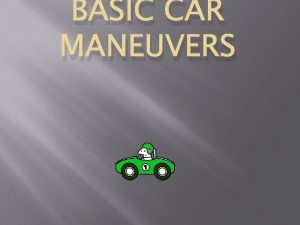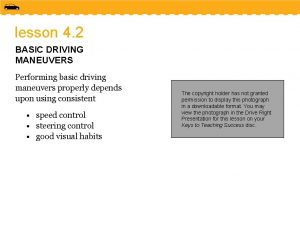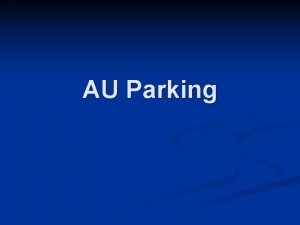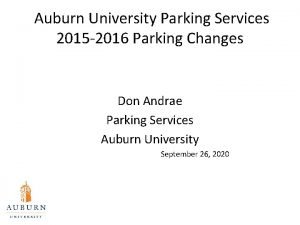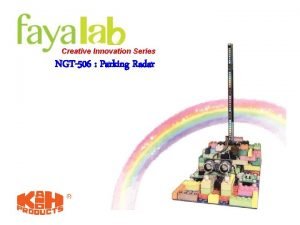lesson 4 3 PARKING MANEUVERS Parking your car
























- Slides: 24

lesson 4. 3 PARKING MANEUVERS Parking your car is a skill. To park easily, you need to control the vehicle with steering, braking, and an understanding of reference points. The copyright holder has not granted permission to display this photograph in a downloadable format. You may view the photograph in the Drive Right Presentation for this lesson on your Keys to Teaching Success disc.

OBJECTIVE Explain the differences among the three parking maneuvers.

There are three basic ways to park: A. Angle Parking spaces can be at the curb of a street or in a parking lot. B. Perpendicular Parking is only used in parking lots. C. Parallel Parking is a method of backing between two vehicles that are parked alongside a curb.

Reference Points A reference point is some part of the outside or inside of the vehicle, as viewed from the driver’s seat, that relates to a part of the roadway. Knowing reference points enables you to put your vehicle exactly where you want it.

Types of Reference Points The reference points on a vehicle that are typical for most drivers are called standard reference points. A personal reference point is an adaptation of a standard reference point for your own vehicle. The forward reference point is when steering should begin during a maneuver.

OBJECTIVE Describe how to perform each parking maneuver.

Angle and Perpendicular Parking Angle Parking It is the easiest parking procedure to perform, but the most dangerous to exit because you will be backing into traffic. To park in an angle space: 1. Check behind you. Is the space legal and clear of obstacles and pedestrians? Tap your brake lights. 2. Have at least 6 feet of side space away from the parked vehicles. Your forward reference point is the center of the space at the curb.

3. Quickly turn the steering wheel while the vehicle is moving slowly. 4. Line up with a target at curbside, such as a parking meter. Straighten the car and tires. 5. Place the tip of the bumper even with the curb.

Perpendicular Parking Follow the same steps as for angle parking, except you will need at least 8 feet of side space from the parked vehicles.

Leaving an Angle or Perpendicular Space Backing out of a parking space is a high-risk maneuver because you will be backing into a potential traffic flow with your view blocked. 1. Creep straight back by controlling speed with your brake. 2. When your front bumper is even with the rear bumper of the vehicle that is on the opposite side of where the back of your vehicle will go, begin to turn the steering wheel. 3. Stay close to the parked cars when backing to reduce risk from approaching traffic. 4. Straighten the tires, shift to a forward gear. Proceed forward as you check the front. 5. Recheck behind you for fast-approaching vehicles.

Perpendicular Back-In Parking You can reduce the risk of perpendicular parking by backing into the space, eliminating the need to back out of it. 1. Signal a right turn. Check traffic to the rear, and tap your brake lights. 2. Position your vehicle so that its side is 3 feet from the parked cars, and your body appears to be aligned with the center of the parking space.

3. Select a target 45 degrees to your left, using the outer edge of the driver’s side mirror.

4. Align your vehicle with the target while quickly turning the steering wheel. 5. Line up your car with the parking space. Straighten your tires and shift to REVERSE. 6. Back until the corner of the car parked next to your space is in your rear window’s blind spot, then quickly turn the steering wheel all the way to the right while backing slowly.

7. When your car is properly aligned in the space, straighten your tires. Back until the back line of the space appears to be in the middle of the rear side window.

Parallel Parking Use parallel parking to park parallel to the curb. Select a space that is 5 to 6 feet longer than your vehicle. 1. Signal a right turn and flash your brake lights. Be sure it is legal and clear of objects. Stop about 3 feet away from the parked cars. 2. Pull forward so that your rear bumper is even with the rear bumper of the vehicle parked in front of the space you want to enter.

3. Back slowly. When the back of the passenger’s seat is even with the rear bumper of the front vehicle, straighten the wheels. Look over your shoulder, through the rear window.

4. When your front bumper is even with the front vehicle’s back bumper, turn the wheel sharply left towards the street. Continue to back slowly to clear the front car’s rear bumper. Check to the back and front continually.

5. Straighten your tires and center the car when your vehicle is parallel to the curb.

Leaving a Parallel Parking Space You are responsible for avoiding a collision when leaving a parallel parking space. Search for a safe gap and yield to all oncoming vehicles. 1. Slowly back straight until your rear bumper almost touches the vehicle behind you. Turn the wheels sharply left as you stop. Signal left, check left mirror and blind spot. 2. Move forward slowly. Check the right-front corner for clearance.

3. When halfway out of the parking space and your passenger door is aligned with the street-side corner of the parked car, turn your wheels slowly to the right. 4. Scan the front again, and accelerate as you center your vehicle in the traffic lane.

Parking on Hills When parking uphill against a curb, turn the front wheels to the left.

When parking uphill or downhill where there is no curb, turn your wheels to the right.

When parking downhill against a curb, turn the front wheels to the right.

lesson 4. 3 review 1. List the three basic types of parking methods. 2. How should the tires be turned when parked uphill with a curb?
 Qq moves
Qq moves Parking maneuvers worksheet
Parking maneuvers worksheet Multi level car parking system project report
Multi level car parking system project report Condeco user guide
Condeco user guide Munich airport parking
Munich airport parking Cont de car parking
Cont de car parking Pss parking
Pss parking Car to car communication consortium
Car to car communication consortium Ch7on
Ch7on Chapter 1 lesson 1 your total health
Chapter 1 lesson 1 your total health Burns marshall maneuver
Burns marshall maneuver Flow restricted oxygen powered ventilation device
Flow restricted oxygen powered ventilation device Vagal maneuvers
Vagal maneuvers Sellicks maneuvers
Sellicks maneuvers Pals hypovolemic shock algorithm
Pals hypovolemic shock algorithm Vagal maneuvers
Vagal maneuvers Vagal maneuvers
Vagal maneuvers Appendicitis maneuvers
Appendicitis maneuvers Parking diagonally to a curb.
Parking diagonally to a curb. Performing basic maneuvers chapter 4
Performing basic maneuvers chapter 4 Chapter 4 performing basic maneuvers answer key
Chapter 4 performing basic maneuvers answer key Leopold maneuvers
Leopold maneuvers Types of turnabouts
Types of turnabouts The safest turnabout maneuver is
The safest turnabout maneuver is Chapter 6 performing basic vehicle maneuvers
Chapter 6 performing basic vehicle maneuvers

